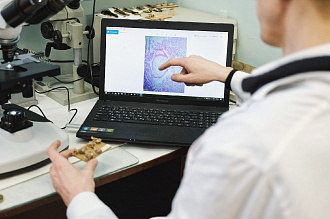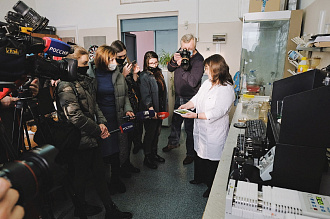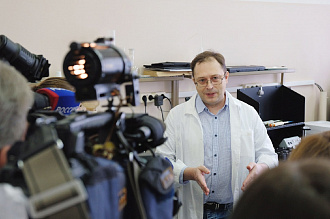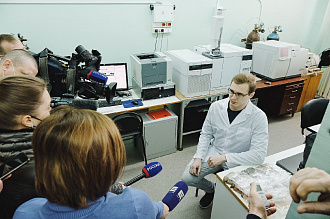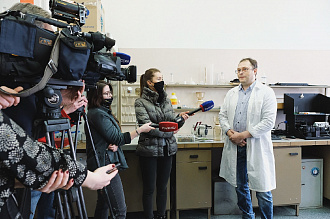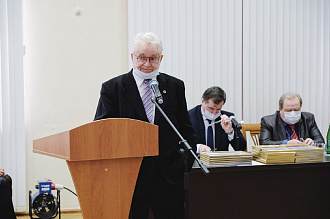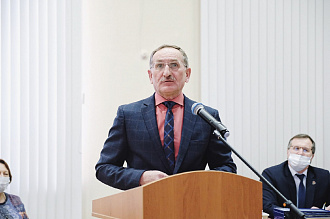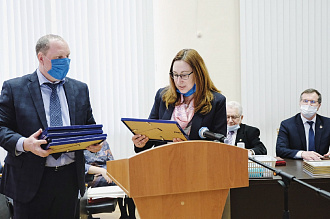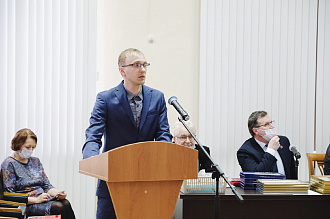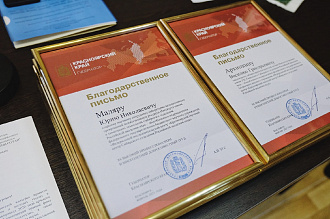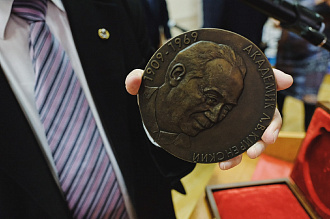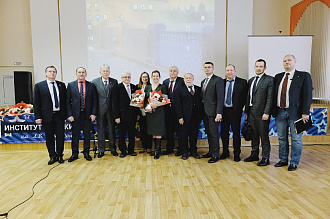On the Day of Russian Science, Krasnoyarsk scientists presented the important results of last year
8 February 2021 г. FRC KSC SB RAS
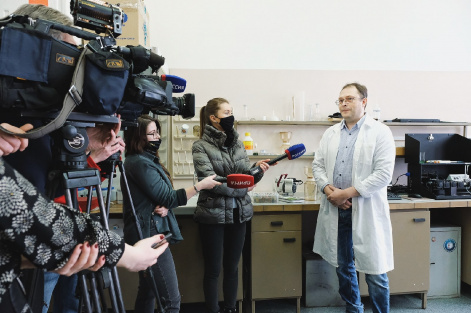
In the first half of the day, a tour for the regional media was organized to the institutes of the Krasnoyarsk Science Center of SB RAS. The journalists were shown several laboratories which study the quality of the environment.
In 2020, scientists of the Institute of Biophysics took part in the Great Norilsk Expedition, they took samples of water and plants and animals in the area of the oil spill and downstream, up to the confluence into Lake Pyasino. Also, a team of scientists performed sampling in the Abakan channel to analyze the causes of its blossoming within the area of the city of Krasnoyarsk.
Elena Kravchuk, Candidate of Biological Sciences, Senior Researcher, and Alexander Tolomeev, Candidate of Biological Sciences, Senior Researcher, told what needs to be done to assess the impact of pollution on the reservoir, what devices are used for this, how the collected samples are analyzed and how the information is processed. Journalists learned about the first results of assessing the impact of the oil spill on Arctic water bodies and when the Yenisei will become clean within the city of Krasnoyarsk.
The Institute of Chemistry and Chemical Technology has a modern instrument base and supports analytical methods for analyzing the content of a wide range of pollutants (heavy metals, organic pollutants) in liquid and solid media.
Junior researchers Vladislav Ionin and Andrey Skripnikov told about their participation in the Great Norilsk Expedition, sampling and methods of analysis of water, soil and bottom sediment samples, and they presented the first results of research.
Scientists at the Institute of Forest have recently developed a unique methodology for assessing the impact of various pollution on terrestrial ecosystems. For this they use small rodents. External and internal appearance of tissues and organs, peculiarities of the skeleton development - these signs allow one to determine whether pollution affected living organisms or not.
Doctor of Biological Sciences, Alexander Shishikin and Candidate of Veterinary Sciences, Andrey Lyuto told why this type of animals was chosen to be used un this technique, how they are caught in nature, what methods are used for analysis. The journalists learned about the first results of assessing the impact of the oil spill on animals in the north, and about other examples of using the method to assess the quality of the environment in the Krasnoyarsk Region.
Scientists of the Krasnoyarsk Science Center of SB RAS have created their own research network of air quality monitoring in Krasnoyarsk. Certified and calibrated automated air pollution control stations established throughout the city transmit data to the data center. The accumulated information is used for scientific research and development aimed at solving problems of improving the environmental situation in Krasnoyark. Instrument readings can be monitored online at http://air.krasn.ru. Scientists are planning to expand the observation network, identify sources and perform spatial-temporal analysis of the air pollution in Krasnoyarsk.
Oleg Yakubailik, Candidate of Physical and Mathematical Sciences, Head of the Laboratory of Space Systems and Technologies of the Federal Research Center of KSC SB RAS, told about the operation principles of the entire system and sensors used, demonstrated their operation, and revealed the development prospects.
__________________________
In the afternoon, there was the traditional solemn meeting of the Scientific Council of KSC SB RAS and Council of Rectors of the Krasnoyarsk Region.
In his report, the Scientific supervisor of the Federal Research Center, academician of RAS, Vasily Shabanov presented the most striking results of the scientific work in the Center in 2020. For example, at the L.V. Kirensky Institute of Physics researchers revealed the dependence of the color of blue spruces and glaucous wheat on the structure of their wax coating, which affects the photosynthesis of these plants. Scientists from the Institute of Biophysics, together with the Institute of Chemistry and Chemical Technology, developed special fertilizers for plants which can permanently provide plants with the right amount of nutrients. The academician noted that field tests had already been carried out and the effect had been confirmed. Over the last year at the V.N. Sukachev Institute of Forest, large-scale research was carried out to protect and preserve the forest. At the Institute of Computational Modeling, one of the most promising areas being developed jointly with other institutes is the determination of the possible yield and soil condition using remote sensing. At the Institute of Medical Problems of the North, one of the outstanding results of the year is the identification of markers for diagnosing asthma.
It was noted that the scientists of KSC attracted more than 1.5 billion roubles as external funding in 2020, which is comparable to the amount of budget funding. A special contribution to these advances was made by agricultural enterprises, namely, by the experimental farms "Minusinskoye", "Kuraguinskoye" and "Mikhailovskoye".
The Deputy Minister of Education of the Krasnoyarsk Region Denis Guerguilev, the director of the Regional Science Foundation Irina Panteleeva, the deputy of the Legislative Assembly of the Krasnoyarsk Region Viktor Kardashov, and the head of the administration of the Oktyabrsky district of Krasnoyarsk Gennady Gartman greeted and congratulated the scientists.
In the final scientific report, the candidate of Physical and Mathematical Sciences Nikita Boev, head of the youth laboratory of scientific instrumentation at the L.V. Kirensky Institute of Physics SB RAS told about new devices for the study of thin magnetic films, magnetometers of weak magnetic fields and microwave devices for communication systems.
The laboratory was established at the end of 2018 as part of a special program to support young scientists. The average age of researchers there is 30 years.
Last year, a unique fully automated scanning ferromagnetic resonance spectrometer was created in the laboratory, which allows one to measure the characteristics of thin films locally, for example, at a specific point. This installation can perform tens of thousands of measurements during the day, which previously required about a month of manual work. In addition, the laboratory works with sensors of weak magnetic fields. The developed spectrometer and sensors are better than their foreign counterparts, and they are now manufactured and supplied to the leading laboratories and centers of the country.
Another advanced device developed by the laboratory is near-field magnetic communication system which is capable of operating underwater. The researchers conducted tests at the Krasnoyarsk reservoir. The device was placed at a depth of about 90 meters and it was shown that a video signal can be transmitted in real time even through non-conductive water.
The laboratory closely cooperates with doctors; for example, last year a device was developed to regulate the processes of aspiration of biological material from a wound. Unlike classical devices, which continuously remove substances from the patient's wound and reduce the level of oxygen delivery, the new one has an optical pulse sensor, which allows one to increase blood pressure and, being synchronized with the human heart, to feed the wound with oxygen.
The meeting dedicated to the Day of Russian Science ended with the solemn presentation of letters of gratitude and diplomas to scientists on behalf of the Director of the Federal Research Center of KSC SB RAS and invited guests.
Share:

